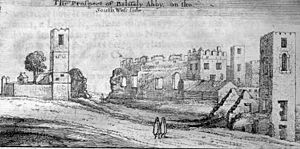Rushen Abbey facts for kids
Quick facts for kids Rushen Abbey |
|
|---|---|

Some of the remains of Rushen Abbey
|
|
| Religion | |
| Affiliation | Cistercian (dissolved in the 16th century) |
| District | 13Ŀ |
| Ecclesiastical or organizational status | museum |
| Year consecrated | 1134 |
| Location | |
| Location | Ballasalla, Isle of Man |
| Architecture | |
| Architectural type | Abbey |
| Completed | 1257 |
| Materials | stone |
Rushen Abbey is an old abbey found in Ballasalla on the Isle of Man. It was once a home for monks, who are religious men living together. It started with a group called the Savignac monks. Later, it became part of the Cistercian order, another group of monks. The abbey was closed down many years ago.
The abbey is about two miles from Castle Rushen. Castle Rushen was a very important place on the island long ago. Both the abbey and the castle are near a river now called the Silver Burn.
A Look Back in Time
Rushen Abbey was built in 1134. A ruler named Óláfr Guðrøðarson gave the land to the Savignac monks. In 1147, the Savignac monks joined with the Cistercian monks. So, Rushen Abbey became a Cistercian abbey. The abbey church, which was for St Mary, was finished in 1257. The abbey was closed in the 1500s. This was part of a big change called the Dissolution of the Monasteries.
In 1853, the Isle of Man Government bought Rushen Abbey. They thought about making it a place for people with mental health issues. But it was never used for that. In 1864, a law was passed to cancel the sale.
In the early 1900s, the abbey ruins became a popular spot for visitors. People loved to eat strawberries and cream in its gardens. After World War II, the abbey became run down. In May 1998, Manx National Heritage took over the abbey. They started to fix it up.
Soon after, archaeologists began digging at the site. They found out a lot about how the monks lived. They learned about their daily routines and practices.
What You Can See Today
Today, Rushen Abbey is a heritage center. It is part of the "Story of Mann" project. There is a building with old items and stories about the abbey. You can also learn about the area around it. The old parts of the abbey have been fixed. There are walkways so visitors can get a close look.
The abbey is open to the public from April to October. You need to pay a small fee to get in. Before you go into the gardens, you walk through a museum. This museum explains the abbey's history. It has interactive displays, audio, and videos. At the end of the museum, there is a special area for children. Kids can build an arch there. They can also learn about the monastery in a fun way. The center uses the phrase "Monky business" to invite children.
The Chronicle of Mann was written at Rushen Abbey. Many other important island documents were also made here. This makes the abbey very important. It was the main place for learning and writing on the island.
The Monks' Bridge
Sometimes, monks from Rushen Abbey had farms in the north of the island. Around 1350, a special bridge was built. This bridge was for packhorses, which carried goods. It helped the monks cross the nearby Silverburn River. Today, it is called The Monks' Bridge or The Crossag. It is one of the few old packhorse bridges left in the British Isles.
Important Burials
Some important people were buried at Rushen Abbey:


